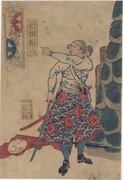Prints in Collection
| Illustration of the Rebels Being Suppressed at Kagoshima, 1877 IHL Cat. #451 | Rokkasen Kyōga no Suminuri, 1880 IHL Cat. #1176 | IHL Cat. #2138 and #2139 |
featuring the play Motomezuka migawari Nitta, 1892 IHL Cat. #730 | Illustration of The Sino-Japanese War, Ansong (Anjō) Crossing, Korea, 1894 IHL Cat. #1949 |
IHL Cat. #1040 |
| Meiji-za Shin Kyogen - Soga Taimen (Soga Brothers Confrontation: A New Play at the Meiji-za), 1902 IHL Cat. #847 |  |  IHL Cat. #665 IHL Cat. #665 |
Biographical Data
Biography
Utagawa Kunimasa IV 四代 歌川国政 (1848 – 1920)
Sources: Guide to Modern Japanese Woodblock Prints:1900 – 1975, Helen Merritt and Nanako Yamada, University of Hawaii. 1992, p. 14; The Hotei Encyclopedia of Japanese Woodblock Prints, Amy Reigle Newland, Hotei Publishing Company, 2005, Volume 2, p. 503.
Originally born Takenōchi Hidehisa 竹内栄久, the artist used multiple gō (artist names) during his career including Baidō Hōsai 梅堂豊斎, Baidō Kunimasa 梅堂国政, Kōchōrō 香朝楼, Kunimasa 国政 IV, Kunisada 国貞 III and Toyokuni 豊国 V. Early in his career he used the gō Kunimasa IV and Baidō Hōsai. In 1889 he succeeded as head of the Utagawa line and took the gō Kunisada III. Later in his career he claimed the title Toyokuni IV, but that gō was already taken (a fact that he refused to recognize), so he is referred to as Toyokuni V.
Originally born Takenōchi Hidehisa 竹内栄久, the artist used multiple gō (artist names) during his career including Baidō Hōsai 梅堂豊斎, Baidō Kunimasa 梅堂国政, Kōchōrō 香朝楼, Kunimasa 国政 IV, Kunisada 国貞 III and Toyokuni 豊国 V. Early in his career he used the gō Kunimasa IV and Baidō Hōsai. In 1889 he succeeded as head of the Utagawa line and took the gō Kunisada III. Later in his career he claimed the title Toyokuni IV, but that gō was already taken (a fact that he refused to recognize), so he is referred to as Toyokuni V.
He studied under Toyokuni III at age 11 and then under Utagawa Kunisada I (1786–1865) and Utagawa Kunisada II (1823-1880).
He specialized in Meiji actor prints and along with Toyohara Kunichika (1835–1900) is considered by some as the best of the yakush-e artists. He also designed senso-e (war prints), kaika-e (pictures of modernization), e-hon (book illustrations), senjafuda (privately published votive slips) and a type of game board, e-sugoroku.
His eldest son was the artist Utagawa Kokunimasa (1874-1944).
"Hōsai died from illness, age 72, on 26 October 1920 at his home in Asakusa-tamachi. Following his death, his role in the history of Meiji actor prints was largely forgotten and overshadowed by the accomplishments of the more prolific, and creative, figure of Kunichika. But perhaps we should re-assess Hōsai's role and accord him a position, if not the most innovative of designers, then at least as a final figure in the long line of Utagawa school actor image makers."1
1 "In the Shadow of Another: Introducing the 'Meiji no Edokko' Baidō Hōsai," Amy Reigle Newland, Andon 89 (December 2010), p. 21.
An In Depth Look at the Artist Baidō Hōsai
A fascinating and in-depth article on the artist titled "In the Shadow of Another: Introducing the 'Meiji no Edokko' Baidō Hōsai" by Amy Reigle Newland can be found in Andon 89 (December 2010), bulletin of the Society for Japanese Arts.

Laurance P. Roberts, Weatherhill, 1976, p. 97
Sample Signatures and Seals Attributed to Artist
 Baidō Kunimasa hitsu |  Baidō Kunimasa hitsu with Toshidama seal (1880) |  Baidō Hōsai hitsu (1902) |  梅堂国政 画 Baidō Kunimasa ga |  梅堂国政 図 Baidō Kunimasa zu with Toshidama seal (1877) |  Hōsai hitsu with Toshidama seal (1896) |
Kōchōrō Hōsai hitsu with Baidō seal |  Kōchōrō Hōsai hitsu with Hōsai seal |  Ōju Kōchōrō hitsu with Toshidama seal |  Hōsai hitsu, with Baidō seal, 1897 |  Utagawa Hōsai hitsu, with Baidō seal, 1903 |  香朝楼国貞筆 Kōchōrō Kunisada hitsu with Toshidama seal |
 梅堂 筆 Baidō hitsu (1894) |
last revision:
11/11/2018











![Illustration of [The Emperor’s Carriage] Departing the Imperial Palace [over] Nijūbashi](../visual-index-of-prints-t---z/Departing the Imperial Palace-c8f4f3e6fe8605d5.jpg)










